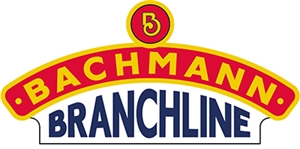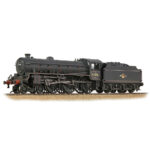As part of our Winter 2022 British Railway Announcements we are excited to unveil the all new Mainline Hunslets in OO9 scale from Bachmann Narrow Gauge. From our trio of launch models, we present ‘Linda’ in Late Penrhyn Quarry Lined Black livery with a weathered finish.
Following the success of the multi-award winning Double Fairlie locomotives, we’ve chosen another prototype famous for its operation on the narrow gauge railways of North Wales to join the Bachmann Narrow Gauge range next. A Class of just three locomotives, each of the Mainline Hunslets can now be modelled faithfully at various points during their working lives thanks to our versatile tooling suite. Incorporating the highest levels of detail to produce a model of supreme fidelity, this Mainline Hunslet is brought to life by its exquisite livery application using the latest paint application techniques for the most authentic of finishes.
These small but mighty models feature a diecast metal saddle tank, cylinder block, frames and footplate; coupled with a precision moulded cab, smokebox and other separate detail components to produce a model that is strong and robust yet intricately detailed. The cab interior is a work of art and behind the hinged, posable firebox door, firebox lighting is fitted, and this operates on both analogue and DCC. Talking of DCC, with a Next18 DCC decoder socket and a pre-fitted speaker it’s easy to convert your model for DCC running – or why not make it even easier and opt for a SOUND FITTED model to really bring your layout to life!
MODEL FEATURES:
- Bachmann Narrow Gauge OO9 Scale
- Era 4
- Weathered Penrhyn Quarry Lined Black (Late) livery
- Named ‘Linda’
- Etched Name Plates and Works Plates included
- Equipped with a Next18 DCC Decoder Socket – Recommend Decoder item No. 36-567A
- Length 67mm
DETAIL VARIATIONS SPECIFIC TO THIS MODEL
- Welded Saddle Tank
- Round Cab Front Windows
- Tool Brackets on Right Hand Side of Saddle Tank
- Round Sanding Pots mounted on the front of the Saddle Tank
- Single Piece Smokebox Handrail
MECHANISM:
- Coreless motor with flywheel
- Electrical pickup from all wheels
- Separate metal bearings fitted to each axle
- Diecast metal chassis block
- 9mm (OO9 narrow gauge) wheels to NEM310 standards with authentic profile and detailing
- Coupling pockets to NEM355 standards, into which a standard OO9 coupling hook assembly is fitted (hook and loop coupling also supplied for optional fitting)
- Designed to operate on curves of first radius (228.6mm) or greater
DETAILING:
- Diecast metal cylinder block, frames, footplate and saddle tank
- Precision moulded plastic smokebox and cab
- Highly detailed and decorated cab interior including separately fitted regulator, reverser leaver, handbrake, and gauge frames and hinged firebox door which can be posed open/closed
- Separately applied details including reverser, injectors, handrails, smokebox dart, whistle and tool brackets (where applicable)
- Each model supplied with a set of authentically decorated etched name plates and works plates
Lighting:
- Firebox Glow (on analogue) / Firebox Glow & Flicker (on DCC or when SOUND FITTED models are used on analogue)
DCC:
- Next18 DCC decoder interface
SOUND:
- Speaker installed in all models for optimum sound reproduction
- Zimo MX659N18 DCC Sound Decoder fitted to SOUND FITTED versions
- Sound files produced specifically for the Bachmann Narrow Gauge Mainline Hunslet using recordings from real locomotives
- SOUND FITTED models operate on DCC and Analogue control as supplied
LIVERY APPLICATION:
- Authentic liveries applied to all models
- Multiple paint applications employed on each model
- Logos, numerals and text added as appropriate using multi-stage tampo printing incorporating authentic typefaces, logos and colours
MAINLINE HUNSLET HISTORY
Most famous for their operation on the North Wales narrow gauge railways, the first main line Hunslet was built in 1882 by the Hunslet Engine Company of Leeds for the Penrhyn Quarry Railway. Named ‘Charles’, the locomotive’s somewhat unconventional appearance, with steeply inclined cylinders and connecting rods located on the inside of the coupling rods, would be repeated eleven years later when ‘Linda’ and ‘Blanche’ were constructed. Known affectionately by many enthusiasts as ‘the Ladies’, they were ostensibly built to the same 0-4-0 saddle tank design as ‘Charles’, although the ‘Ladies’ did incorporate some differences when compared to their elder. They had larger fire grates for one, round spectacle glasses in the front cab sheet rather than the square ones fitted to ‘Charles’ for another, and were also fractionally longer.
Penrhyn Quarry was the largest slate quarry in the world at the end of the nineteenth century and the trio of Hunslets spent their days hauling slate trains over the Penrhyn main line from the vast quarry complex at Coed-y-Parc, near Bethesda, to Port Penrhyn, just a stone’s throw from Bangor on the North Wales coast. Here, slate products were transferred to standard gauge railway wagons or ships for onward transport around the UK and further afield. Whilst smaller locomotive such as the Quarry Hunslets were used to work the quarry’s internal railways, the larger, more powerful Mainline Hunslets worked the full trains from the quarry down to Port Penrhyn and brought the empty wagons back again – similar duties to those for which the Ffestiniog Railway employed the famous Double Fairlies.
During their working lives the three locomotives underwent several changes, all gained full-height rear cab sheets, replacing the original half-height sheets, welded tanks were fitted in place of the original rivetted versions and various sandbox arrangements were seen, amongst other improvements during their time on the Penrhyn line. By the mid-twentieth century traffic on the Penrhyn Quarry Railway was in decline and in 1962 the last trains ran. ‘Charles’ had already been retired in in the mid-1950s, but the Ladies worked on until the very end.
Offered for sale upon closure of the railway, ‘Linda’ was quickly loaned to the Ffestiniog Railway, arriving there only three days after hauling her last train on the Penrhyn Quarry Railway. In 1963 ‘Linda’ was purchased by the Ffestiniog Railway and ‘Blanche’ too was acquired in the same year, arriving at the railway in December 1963. Both Ladies have been modified by the Ffestiniog Railway since their acquisition, most notably with the fitting of front pony wheels and tenders, becoming 2-4-0ST+Ts (saddle tank tender engines). With 2023 marking 60 years since the pair were brought by the Ffestiniog Railway, they are unquestionably two of the most useful engines in the railway’s fleet and are as popular as ever with visitors, staff and volunteers alike.
‘Charles’ was also offered for sale, but with the boiler condemned, the Ffestiniog Railway declined. Instead, ‘Charles’ was loaned to the National Trust and is now displayed at Penrhyn Castle – once the family home of the owners of Penrhyn Quarry.

![391-127 mainline hunslet 0-4-0st 'linda' penrhyn quarry lined black (late) [w]-23578-large](https://modelrailwayshop.uk/wp-content/uploads/2024/01/391-127-mainline-hunslet-0-4-0st-linda-penrhyn-quarry-lined-black-late-w-23578-large.jpg)
![391-127 mainline hunslet 0-4-0st 'linda' penrhyn quarry lined black (late) [w] -3-25707-large](https://modelrailwayshop.uk/wp-content/uploads/2024/01/391-127-mainline-hunslet-0-4-0st-linda-penrhyn-quarry-lined-black-late-w-3-25707-large.jpg)
![391-127 mainline hunslet 0-4-0st 'linda' penrhyn quarry lined black (late) [w] 08-25706-large](https://modelrailwayshop.uk/wp-content/uploads/2024/01/391-127-mainline-hunslet-0-4-0st-linda-penrhyn-quarry-lined-black-late-w-08-25706-large.jpg)
![391-127 mainline hunslet 0-4-0st 'linda' penrhyn quarry lined black (late) [w] 07-23584-large](https://modelrailwayshop.uk/wp-content/uploads/2024/01/391-127-mainline-hunslet-0-4-0st-linda-penrhyn-quarry-lined-black-late-w-07-23584-large.jpg)
![391-127 mainline hunslet 0-4-0st 'linda' penrhyn quarry lined black (late) [w] 06-23583-large](https://modelrailwayshop.uk/wp-content/uploads/2024/01/391-127-mainline-hunslet-0-4-0st-linda-penrhyn-quarry-lined-black-late-w-06-23583-large.jpg)
![391-127 mainline hunslet 0-4-0st 'linda' penrhyn quarry lined black (late) [w] 05-23582-large](https://modelrailwayshop.uk/wp-content/uploads/2024/01/391-127-mainline-hunslet-0-4-0st-linda-penrhyn-quarry-lined-black-late-w-05-23582-large.jpg)
![391-127 mainline hunslet 0-4-0st 'linda' penrhyn quarry lined black (late) [w] -04-23581-large](https://modelrailwayshop.uk/wp-content/uploads/2024/01/391-127-mainline-hunslet-0-4-0st-linda-penrhyn-quarry-lined-black-late-w-04-23581-large.jpg)
![391-127 mainline hunslet 0-4-0st 'linda' penrhyn quarry lined black (late) [w] 02-25705-large](https://modelrailwayshop.uk/wp-content/uploads/2024/01/391-127-mainline-hunslet-0-4-0st-linda-penrhyn-quarry-lined-black-late-w-02-25705-large.jpg)
![391-127 mainline hunslet 0-4-0st 'linda' penrhyn quarry lined black (late) [w]-23578-large](https://modelrailwayshop.uk/wp-content/uploads/2024/01/391-127-mainline-hunslet-0-4-0st-linda-penrhyn-quarry-lined-black-late-w-23578-large-100x100.jpg)
![391-127 mainline hunslet 0-4-0st 'linda' penrhyn quarry lined black (late) [w] -3-25707-large](https://modelrailwayshop.uk/wp-content/uploads/2024/01/391-127-mainline-hunslet-0-4-0st-linda-penrhyn-quarry-lined-black-late-w-3-25707-large-100x100.jpg)
![391-127 mainline hunslet 0-4-0st 'linda' penrhyn quarry lined black (late) [w] 08-25706-large](https://modelrailwayshop.uk/wp-content/uploads/2024/01/391-127-mainline-hunslet-0-4-0st-linda-penrhyn-quarry-lined-black-late-w-08-25706-large-100x100.jpg)
![391-127 mainline hunslet 0-4-0st 'linda' penrhyn quarry lined black (late) [w] 07-23584-large](https://modelrailwayshop.uk/wp-content/uploads/2024/01/391-127-mainline-hunslet-0-4-0st-linda-penrhyn-quarry-lined-black-late-w-07-23584-large-100x100.jpg)
![391-127 mainline hunslet 0-4-0st 'linda' penrhyn quarry lined black (late) [w] 06-23583-large](https://modelrailwayshop.uk/wp-content/uploads/2024/01/391-127-mainline-hunslet-0-4-0st-linda-penrhyn-quarry-lined-black-late-w-06-23583-large-100x100.jpg)
![391-127 mainline hunslet 0-4-0st 'linda' penrhyn quarry lined black (late) [w] 05-23582-large](https://modelrailwayshop.uk/wp-content/uploads/2024/01/391-127-mainline-hunslet-0-4-0st-linda-penrhyn-quarry-lined-black-late-w-05-23582-large-100x100.jpg)
![391-127 mainline hunslet 0-4-0st 'linda' penrhyn quarry lined black (late) [w] -04-23581-large](https://modelrailwayshop.uk/wp-content/uploads/2024/01/391-127-mainline-hunslet-0-4-0st-linda-penrhyn-quarry-lined-black-late-w-04-23581-large-100x100.jpg)
![391-127 mainline hunslet 0-4-0st 'linda' penrhyn quarry lined black (late) [w] 02-25705-large](https://modelrailwayshop.uk/wp-content/uploads/2024/01/391-127-mainline-hunslet-0-4-0st-linda-penrhyn-quarry-lined-black-late-w-02-25705-large-100x100.jpg)










